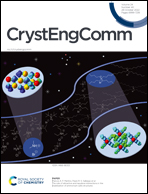Ferroelectric monodisperse Ln-doped barium titanate cuboidal nanocrystals prepared by a solvothermal route†
Abstract
We demonstrate here that the dielectric, electrical and optical properties of BaTiO3 colloidal nanocrystals with a cuboidal shape can be modulated upon aliovalent doping with Ln3+ rare earth ions (Ln = La3+, Ce3+, Nd3+, Sm3+, Gd3+, Dy3+, and Tm3+). Ba1−xLnxTiO3 nanocubes (0.01 ≤ x ≤ 0.07) were synthesized by a highly versatile, energy-efficient, and simple solvothermal route at temperatures as low as 180 °C. Transmission electron microscopy micrographs and analysis of the particle size distribution revealed that the resulting nanocubes are highly crystalline, monodisperse, and possess a cuboidal shape. Vibrational spectroscopy and optical measurements were used to study the surface composition of the Ln-doped BaTiO3 colloidal nanocrystals, surface characteristics, bandgap energies and the nature of binding occurring between the capping ligand and the metal ions. Analysis of the symmetric, asymmetric vibrational modes and wavenumbers associated with the carboxylate ions revealed that the oleic acid ligand binds to the ions present on the surface of the Ba1−xLnxTiO3 nanocubes via a bidentate coordination mechanism. As revealed by powder X-ray diffraction, the nanocrystals are single-phase and possess a non-centrosymmetric structure, as suggested by Raman spectroscopy. The Williamson–Hall method was used to estimate the crystallite size and subsequently calculate the structural strain occurring within the nanocrystals. The marginal difference between particle and crystallite sizes confirmed that the nanocubes have a single-crystalline internal structure. Dielectric spectroscopy of the Ba1−xLaxTiO3 nanocube sample revealed values of the dielectric permittivity higher than that of the parent nanomaterial along with excellent tan δ values, which confirms the incorporation of the Ln3+ ions under solvothermal conditions at low temperature. Piezoresponse force microscopy measurements performed on these nanocrystals showed that the permanent, reversibly switchable polarization observed in the parent material is preserved upon incorporation of the Ln3+ ions into the perovskite host crystal. The bandgap value of the BaTiO3 colloidal nanocrystals decreased significantly upon incorporation of lanthanoid ions into the perovskite host lattice.



 Please wait while we load your content...
Please wait while we load your content...